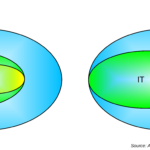ICTs in the Health Sector
In most countries, the health sector has been one less prone to rapidly adopt state of the art ICTs for its core functions and operations. e-health, as it is called, is thus still in its infancy, specially in developing countries. This situation is in sharp contrast with the rapid adoption of new technologies and procedures in the sector to make more effective preventive diagnostics (CAT Scans, MRIs, digital x-rays) or undertake non-invasive sophisticated medical procedures to tackle complicated health issues (use of laser and computers to perform precision-based complicated surgical procedures, etc.). But the two are also related: the high costs of the state of the art equipment and knowledge forces many providers to put their resources here as a priority thus leaving ICT investments in operations and management as a second tier priority, it at all.
However, the situation is not the same when we take into account public and private health providers. While the former has started in some countries large scale efforts to introduce ICTs into the overall management and operations of the sector( including patient record management systems), the public sector usually lags when it comes to the adoption the latest technologies for diagnostics and procedures, in grand part due to costs. This is certainly the case in most poor countries where such technologies are largely unavailable (or if available, unsustainable).
The private health sector is a universe of many SMEs combined with a relatively few large providers of health services. While many of these SME, and most large providers, do use ICTs many are still lagging due to both costs and internal capacity. SME atomization (and intense competition among them, is some cases) also prevents the creation of standards and guidelines for the inter-exchange of patient information and health histories. It also poses a challenge for public health sector when it comes to getting information and data about patients attending a plethora of providers. Private health insurance companies are best positioned here as small providers who need to make insurance claims are required in some cases to do it through web services. But they have no interest in sharing such information with other providers or with the public sector. We are thus facing here the now classical issue on interoperability; only this time it involved the private sector too (see http://www.nehta.gov.au/component/docman/doc_download/106-interoperability-fact-sheet for an example of an e-health interop framework).
e-health Scope
ICT investments in health provision can tackle different areas of the sector. Perhaps the most well known (and the first to emerge) is telemedicine. Patient record management (PRM) and health information systems (HIMs) are the most common and most demanded nowadays. On the demand side (patient or people side), digital access to health information on line has also grown substantially -to the point that some health providers are concerned about the explosion of health information online without any apparent vetting or verification (so maybe a WikiHealth is needed here based in the successful WikiMedia model, at least for the public sector).
And finally, m-health has also taken off due to he explosive growth of mobile technologies and devices and the lowering of access and use entry barriers for both doctors and patients. M-health is also changing the ways patient and medical suppliers interact. M-health might prove to be of critical importance in developing countries where access to both health service and the Internet is still scant. It can also be seen as a catalyst to accelerate the achievement of MDG targets related to health.
PRM and HIMs
Sophisticated HIMs and PRM solutions exist nowadays in a market that according to recent report is growing in exponential fashion. Not surprisingly, both new and traditional ICT companies and now focusing on furnishing such solutions -many of them integrated into ine single platform. However, the cost of such solutions can certainly be out of reach for many public sector providers in the developing world. In addition, even if bought off the shelf, such solutions will need to be customized and localized (including languages) to national and local contexts. This will add to the implementation costs. In addition, some of these solutions might required broadband access to the Internet to be effectively used. Finally, some may also make use of proprietary data standards that can impede the interconnection of dissimilar health systems into one single “cloud” of operations and data
Enter Free/Open Source Software (FOSS) HIM/PRM solutions which can solved many of these issues while reducing costs. The latter alone is perhaps not the only reason to consider FOSS. Perhaps more important is the fact that FOSS can help develop national capacities to sustain the efforts and also foster innovation within the sector as usage spreads around and new FOSS users emerge, specially within the youth, and seek new areas of work and development. On the other hand, we should not forget that FOSS also requires that the country planing to use it initially has basic capacity to effectively use and deploy FOSS and enhance it the short run. In this context, FOSS is not a panacea (see for example http://www.erpicum.net/log/2011/02/25/open-source-software-and-ehealth-how-to-lower-the-barriers/).
FOSS Solutions
There are also a plethora of FOSS e-health solutions (see for example http://www.ehealthopensource.org/).
UNDP has worked with two FOSS providers in the recent past. They are:
- GNU Health (http://health.gnu.org/) which is an integrated health solution specifically targeted to developing countries and poor sectors of the population. It has been deployed in 10 countries and have recently enter into partnership with UNU. GNU health recently announced its support to MDG 6 and NTDs
- VISTA (http://vistapedia.net/index.php?title=What_is_VistA_Really) is the Veterans Health Information System and Technology Administration platform developed over the last 2o years by the US Veteran Health Administration. Although initially focused in the US, it has now been deployed in over 15 countries, including developing nations
Experts supporting these platforms are available to assist UNDP programme countries should they expressed interest in deploying this solutions locally, following UNDP procurement procedures and regulations for their customization and localization. The software itself is available for free on the Internet.
Raúl





